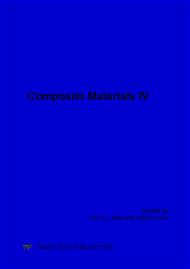p.47
p.53
p.59
p.63
p.69
p.77
p.83
p.91
p.97
Using Friction Stir Processing to Fabricate Mg Based Composites with Nano Fillers
Abstract:
There have been numerous methods in fabricating particulate reinforced metallic matrix composites, including stir casting, squeeze casting, spray forming, powder metallurgy, and mechanical alloying. In this paper, one solid state processing technique, friction stir processing, is applied to incorporate 5-15 vol% nano-sized ceramic particles SiO2 into the AZ61 Mg alloy matrix to form bulk composites, using the characteristic rotating downward and circular material flow around the stir pin. The upper working FSP temperature is controlled to less than 400oC in order to avoid chemical reaction. The fixed pin tool is 6 mm in diameter and 6 mm in length, with a shoulder diameter of 18 mm and a 3o tilt angle. The advancing speed of the rotating pin is kept constant to be 45 mm/min, with rotational speed of the pin from 800 rpm (rotation per min), resulting in a strain rate around 101 s-1. After one-pass FSP, the particle dispersion within the central cross-sectional area of the onion ring regions, measuring nearly 6 mm in diameter, was macroscopically uniform. However, the observed particle size is frequently 0.5-5 µm, much larger than the individual SiO2 size (~20 nm), suggesting the clustering of nano particles. The situation after two FSP passes, with an opposite FSP direction for the second pass, appear to be further improved. Electron microscopy characterizations reveal that the aggregating particles were seen to vary from 10 to 1000 nm in size. Some of the large particles, 1-5 µm in diameter, were identified to be the Mn bearing dispersoids (e.g. Al4Mn) by the SEM-EDS. The average grain sizes of the composites with 5-15 vol% SiO2 varied within 00.5-2 µm, and the composites double the hardness as compared with the as-received AZ61 cast billet.
Info:
Periodical:
Pages:
69-76
Citation:
Online since:
July 2006
Authors:
Keywords:
Price:
Сopyright:
© 2006 Trans Tech Publications Ltd. All Rights Reserved
Share:
Citation:


